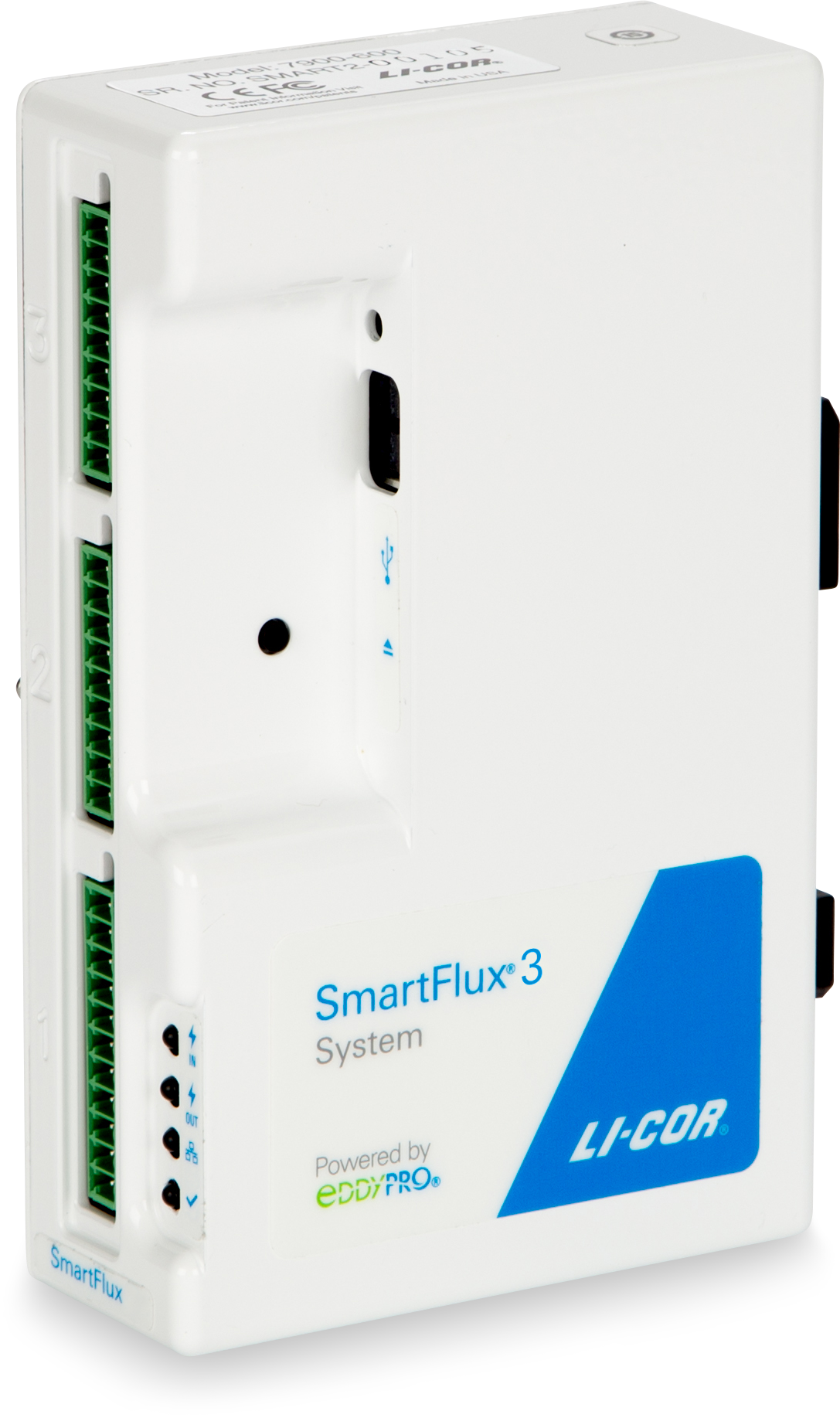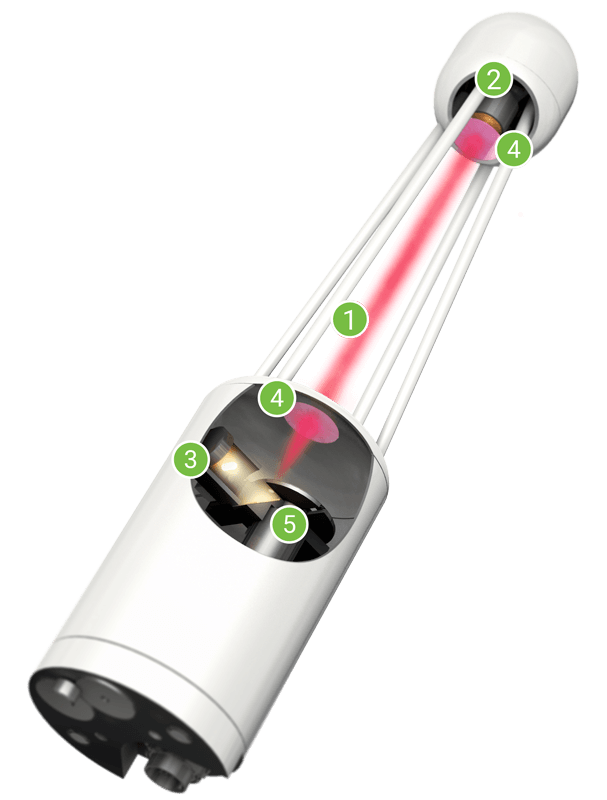LI-7500DS
Open Path CO2/H2O Analyzer
The new LI-7500DS analyzer delivers the performance and dependability of previous LI-7500 models, in a streamlined, lower cost configuration with even lower power requirements.
Get a Quote
The LI-7500DS is designed for high-speed CO2 and water vapor measurements in ambient air. Lower power and maintenance requirements make it ideal for field deployments.
Requiring only 4 watts during normal operation, the LI-7500DS features lower power demands than any other EC gas analyzer available. It is ideal for deployment in remote areas where power is limited.
Omnidirectional sampling provides versatile installation options and continuous data coverage.
Logs complete eddy covariance data sets—including wind speed measurements from a sonic anemometer and supporting meteorological, radiation, and soil data from a LI-COR Biomet System.

Now includes the SmartFlux® System
The SmartFlux® System runs EddyPro® Software on a powerful microcomputer to compute final flux results as data are logged. It delivers the same dependable results you get from EddyPro Software on a desktop computer, only computed in real time at the site.
SmartFlux is ready to connect with FluxSuite® Software — to put your eddy covariance system online. In FluxSuite, you can view results, get email notifications, and check the performance of your instruments from a computer and smartphone.
The LI-7500DS instrument
Miniaturized electronics and simplified hardware make the LI-7500DS easier to use. This compact instrument delivers high-speed measurements and precision needed for flux measurements. Designed for long-term deployment, the LI-7500DS improves upon a proven platform.

Ambient air temperature measurements at the optical path.
Temperature controlled optics and detector provide stable measurements—even in wide temperature fluctuations.
Precision optical components reduce sensitivity to contamination in dusty environments.
Scratch-resistant sapphire lenses for simple cleaning in the field.
High-performance brushless chopper motor provides dependable long-term operation.
How it works
The LI-7500DS uses non-dispersive infrared spectroscopy to measure CO2 and water vapor densities in air.
Infrared radiation is transmitted through temperature-controlled optical filters, then through the open sample path to a thermally regulated lead selenide detector. Some of the infrared radiation is absorbed by CO2 and water vapor in the sample path. Gas densities are computed from the ratio of absorbed radiation to a reference.
From the arctic tundra to the arid deserts, the LI-7500DS is designed for the most demanding environments.
Long-term stability and drift resistance
The accumulation of dust, pollen, chemical residues, and other contaminants on optics of open-path gas analyzers can lead to measurement drift and cause gaps in datasets. Typically, this is not a problem when an instrument is regularly maintained. If an instrument is not maintained, however, there is risk that this accumulation will affect measurements.
Innovations to the optics and electronics ensure that the LI-7500DS collects more accurate and dependable data—even as contaminants begin to accumulate on the optics.
Experimental data from 13 instruments at numerous sites with a wide range of contamination levels consistently show that the optical filters in the LI-7500DS provide significantly more stable measurements than the optical filters in the LI-7500A. Figures 1 and 2 show contamination-related drift data from an urban site adjacent to heavy road traffic.
Figure 1. CO2 measurements from three LI-7500RS analyzers (which use the same optics as the LI-7500DS) and three LI-7500A analyzers (average and spread). The y-axis shows the deviation from a control reference. CO2 measurements from the LI-7500RS analyzers drifted considerably less and had smaller instrument-to-instrument variability than those from the original LI-7500A models. Data show the typical improvement expected from the LI-7500RS analyzer.
Figure 2. Water vapor measurements from three LI-7500RS analyzers (which use the same optics as the LI-7500DS) and three LI-7500A analyzers (average and spread). The y-axis shows the deviation from a control reference. Measurements from the LI-7500RS analyzers drifted several times less, and had smaller instrument-to-instrument variability when compared with original LI-7500A models.
Minimized flow distortion
In eddy covariance systems, airflow distortion can occur when a gas analyzer is inside of, or too close to, the sonic anemometer path. If the gas analyzer is too close, it can disrupt airflow before wind enters the anemometer, leading to errors in the computation. If it is too far away, the instruments will sample different eddies, which also leads to errors.
Specifications
CO2 Measurements
- Calibration Range: 0 to 3000 µmol mol-1
- Accuracy: Within 1% of reading
- Zero Drift(per °C):
- ±0.1 ppm typical
- ±0.3 ppm maximum
- RMS Noise (typical @ 370 ppm CO2):
- @5 Hz: 0.08 ppm
- @10 Hz: 0.11 ppm
- @20 Hz: 0.16 ppm
- Gain Drift (% of reading per °C @ 370 ppm):
- ±0.02% typical
- ±0.1% maximum
- Direct Sensitivity to H2O (mol CO2 mol-1 H2O):
- ±2.00E-05 typical
- ±4.00E-05 maximum
- Calibration Range: 0 to 60 mmol mol-1
- Accuracy: Within 1% of reading
- Zero Drift (per °C):
- ±0.03 mmol mol-1 typical
- ±0.05 mmol mol-1 maximum
- RMS Noise (typical @ 10 mmol mol-1 H2O):
- @5 Hz: 0.0034 mmol mol-1
- @10 Hz: 0.0047 mmol mol-1
- @20 Hz: 0.0067 mmol mol-1
- Gain Drift (% of reading per °C @ 20 mmol mol-1):
- ±0.15% typical
- ±0.30% maximum
- Direct Sensitivity to CO2 (mol H2O/mol CO2):
- ±0.02 typical
- ±0.05 maximum
H2O Measurements
General
- Fundamental Gas Sampling Rate: 150 Hz
- Bandwidth: 5, 10, or 20 Hz; software selectable
- Type: Absolute, open-path, non-dispersive spectroscopy
- Detector: Thermoelectrically cooled lead selenide
- Path Length: 12.5 cm (4.92")
- Air Temperature Thermistor: 10K ohm @ 25 °C thermistor
- Measurement Range: -40 to 70 °C
- Sensor Accuracy: ±0.25 °C from -20 to 70 °C
- Resolution: 0.003 °C @ 25 °C
- Pressure Sensor:
- Measurement Range: 20 to 110 kPa
- Sensor Accuracy: ±0.4 kPa from 50 to 110 kPa
- Resolution: 0.006 kPa
- Outputs: Ethernet
- Operating Temperature Range: -25 to 50 °C (-40 to 50 °C verification on request)
- Relative Humidity Range: 0-95% (non-condensing)
- Weatherproof Rating: Tested to IEC IP65 standard user
- Interface: Windows® PC software
- Power Requirements: 10.5 to 30 VDC
- Steady-State Power Consumption: 4 W typical at 25 °C
8 W max over operating range of -25 to 50 °C - Head:
- Size: Diameter 6.5 cm, Length 30 cm
- Weight: 0.67 kg; 1.3 kg with mounting post
- Head Cable Length: 200 cm
- DSI Box:
- Size: 13.24 × 14.64 × 6.24 cm (H × W × D)
- Weight: 0.93 kg
Specifications subject to change without notice.
Back to Eddy Covariance Products
Design Your Own System
Continue to learn about customizable eddy covariance systems.